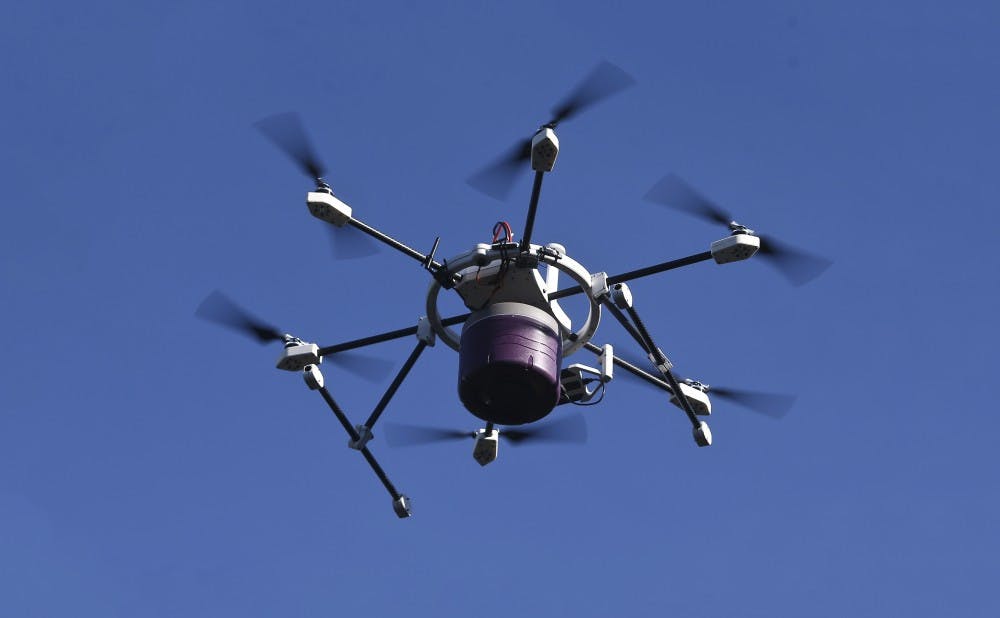Are you suspicious that a drone might be watching you at this very moment? Duke researchers are investigating a drone detection and deterrent method to ease your worries.
With a $750,000 grant from the National Science Foundation, Duke researchers led by Mary Cummings, professor of mechanical engineering and materials science, are teaming up with local areas and other universities to find ways to deter unwanted drones. The project aims to develop affordable devices to detect and report drones to property owners in addition to providing recommendations on how to landscape an area to prevent drone usage.
“Our proposal is that we come up with a solution for you to detect the drones and find out if there are any options that make people less likely to fly drones in your area,” said Rocky Li, a graduate student in the Master of Engineering program who is working on the research.
He explained that there is a lack of inexpensive, user-friendly detection systems on the market. Additionally, the current options available don’t have the technology to notify an owner if drones are being flown on the property in question.
Li is currently working to develop a more affordable detection device that detects the radio waves produced by drones, which are “huge radio emitters.” He plans to test the system in the Duke Gardens—which is a partner in the research—to determine the magnitude of improper drone usage.
He also cautioned property owners against taking any drastic action against drones, no matter how pesky the small aircraft may be.
“The interesting thing is given the [Federal Aviation Administration] statuses on drones—they classify drones as aircraft," he said. "It’s not legally allowed for you destroy or physically incapacitate or affect the drone’s operation in any way while it’s in flight above your property."
Although drone use is permitted at certain times on Duke’s campus, requests to fly a drone outdoors must be pre-approved, according to Duke's drone policy. However, this policy states that there are two sites in the Duke Forest that “have been prescreened as suitable” for drone flying and therefore have a less time-consuming approval process.
William LeFevre, executive director of Duke Gardens, noted that he was excited to collaborate with the researchers.
“We’re part of the University—we like to help other departments and the academic side of the institution with their research if it’s possible,” he said. “It made sense that if [Cummings] was doing research into how to deter unwanted drones from flying in any area, that the Gardens could be a good little outdoor laboratory for that work.”
LeFevre added that drones are spotted flying in the Duke Gardens about “three to four times a year,” but that locating the owner of the drone is often difficult. Sometimes, however, a staff member does find the drone’s operator.
“Generally, it’s innocent and they didn’t realize [the policy],” LeFevre said. “It’s hobbyists, amateurs.”
There are several reasons that drone flying in the Duke Gardens could be dangerous or disturbing, he explained. LifeFlight helicopters heading to Duke Hospital have a landing pad adjacent to the Gardens, so drone flights could pose difficulties for the helicopters’ pilots.
“Just from the standpoint of the safety, privacy and enjoyment of our visitors, it is detrimental to a botanical garden experience to be in the garden and have drones buzzing around your head, and that happens from time to time,” LeFevre said.
A second portion of the project will rely on landscaping experts from Clemson University who will come to the gardens to test their ideas, Li explained. They will examine whether certain landscaping features deter drones more effectively than others.
Hala Nassar, assistant professor of planning and landscape architecture at Clemson, will be involved in this side of the research.
“We will be testing the effectiveness of landscape architecture features, elements and interventions that can make the public safe outdoors,” she wrote in an email.
Li said that the final product of the three-year project will include a paper that advises property owners about possible solutions to unwanted drones. He expected the research would be applicable to public spaces all around the country, especially those that are inundated with uninvited drones.
The Town of Cary government also contacted the researchers to express interest in helping with the project, Li added.
“The better the outreach, the more effective our communications, the more convincing our results will be,” he said.
Get The Chronicle straight to your inbox
Signup for our weekly newsletter. Cancel at any time.

